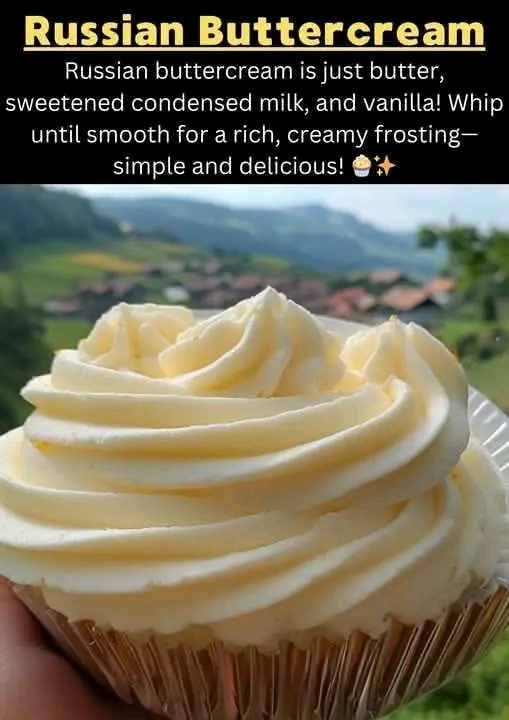Russian Buttercream 🧈🍯
A silky, luxurious frosting made with just a few simple ingredients, Russian Buttercream is a favorite among cake decorators and home bakers alike. Unlike traditional buttercreams that use powdered sugar, this frosting relies on sweetened condensed milk, which gives it a smooth, creamy texture and a delicate sweetness without being overly sugary. It’s perfect for frosting cakes, cupcakes, and even as a filling for pastries.
📜 History of Russian Buttercream
Russian Buttercream, also known as “condensed milk buttercream”, originated in Russia and Eastern Europe during the mid-20th century when sweetened condensed milk became widely available. It quickly gained popularity because of its simplicity and stability compared to sugar-heavy frostings like American buttercream. Today, it remains a classic in Russian and Ukrainian baking traditions, often paired with sponge cakes, honey cakes, and layered tortes.
🥣 Ingredients
- 2 sticks (227 g) unsalted butter, room temperature 🧈
- 1 can (395 g) sweetened condensed milk 🥫
- 1 teaspoon vanilla extract 🌿
- ½ teaspoon salt 🧂
🔍 Method & Formation
This buttercream is created by whipping butter to aerate it, then slowly emulsifying sweetened condensed milk into it. Unlike American buttercream, which uses powdered sugar, Russian buttercream depends on emulsion stability, so both ingredients should be at room temperature.
👩🍳 Instructions
Step 1: Prepare Ingredients
- Ensure your butter is soft but not melted. If it’s too cold, it won’t whip properly; if too warm, it may turn greasy.
- Have your sweetened condensed milk at room temperature for smooth blending.
Step 2: Whip the Butter
- In a large mixing bowl, beat the butter on medium-high speed for 5–7 minutes until it becomes pale, fluffy, and creamy. This step is crucial for a light texture.
Step 3: Incorporate Condensed Milk
- Reduce the speed to low, and gradually add the sweetened condensed milk in a slow, steady stream.
- After all the milk is added, increase the speed to medium-high and whip for another 3–5 minutes until the buttercream is silky and smooth.
Step 4: Add Flavor
- Mix in the vanilla extract and salt until fully combined.
Step 5: Check Consistency
- If the buttercream looks curdled, don’t panic—just keep whipping! It will come together into a smooth, glossy frosting.
💡 Tips & Lovers of This Buttercream
- Cake Lovers adore this frosting because it’s less sweet than American buttercream yet still rich and creamy.
- Pastry Chefs use it for layered tortes, honey cakes (Medovik), and sponge cakes because it’s stable and easy to flavor.
- Home Bakers love it for being easy and quick with minimal ingredients.
✨ Variations
- Add cocoa powder for a chocolate version.
- Mix in fruit puree (like strawberry or raspberry) for a fruity twist.
- Fold in Nutella for a hazelnut flavor.
📦 Storage
- Store in an airtight container at room temperature for up to 2 days or refrigerate for 1 week.
- Before reusing, bring it to room temperature and re-whip for a smooth texture.
✅ Conclusion
Russian Buttercream is an elegant, smooth, and versatile frosting that requires minimal effort yet delivers maximum impact. Its buttery richness and light sweetness make it a perfect companion for a variety of cakes and pastries. Whether you’re a seasoned baker or a beginner, this frosting will elevate your creations to a new level of indulgence.
👉 Do you want me to expand this into a full professional recipe article (with introduction, detailed history, science of emulsion, pairing ideas, and nutrition info) OR turn it into a step-by-step illustrated guide with pictures?
